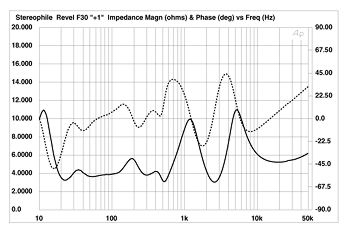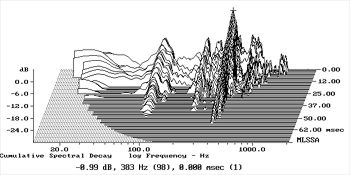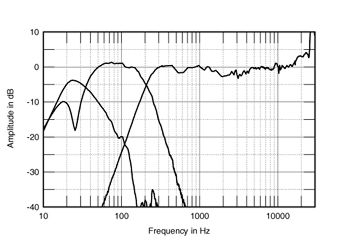| Columns Retired Columns & Blogs |
Revel Performa F30 loudspeaker Measurements
Sidebar 3: Measurements
My estimation of the Revel F30's sensitivity was fractionally higher than specified, at 87.5dB(B)/2.83V/m, but this was within the usual margin of error for this measurement. The impedance (fig.1) hovered around the 4 ohm mark through the midrange, with a generally higher value above that region, even with the tweeter's level control set to "+1" (as it was for this measurement). The phase angle is generally low, but even when it is fairly high, as in the low treble, this never coincides with a minimum magnitude value. There is a coincidence of 45 degrees capacitive angle and 4.5 ohms at 17Hz, but there will never be program material with sufficient energy in this region to tax the partnering amplifier. The slight saddle at 24Hz indicates the tuning of the big flared port, which in turn implies excellent low-frequency extension.

Fig.1 Revel Performa F30, electrical impedance (solid) and phase (dashed) with tweeter level set to "+1." (2 ohms/vertical div.)
The slight wrinkles in the impedance traces at 27kHz indicate the resonance frequency of the metal-dome tweeter, this placed well above the audible range. There are no wrinkles in the midrange to indicate the presence of cabinet resonances, but when I examined the vibrational behavior of the F30's panels with a simple accelerometer, I did find a mode at 383Hz present on all surfaces (fig.2). With such a large cabinet, it will be next to impossible to eliminate all resonances. But what Revel's engineers appear to have done is brace the panels so that what vibrational modes are present are moved as high in frequency as possible and are of relatively high Q, both factors mitigating against their audibility.

Fig.2 Revel Performa F30, cumulative spectral-decay plot calculated from the output of an accelerometer fastened to the front baffle midway between the woofer and the midrange-tweeter panel. (MLS driving voltage to speaker, 7.55V; measurement bandwidth, 2kHz.)
Fig.3 shows the response of the midrange/tweeter section on the F30 tweeter axis at a microphone distance of 50", spliced to the nearfield responses of the midrange unit, woofer, and port. The latter can be seen to cover the bandpass centered on the 20-30Hz region, as expected from the impedance plot, with a clean, resonance-free higher-frequency rolloff. The woofer's minimum-motion notch lies at 25.4Hz, and the unit smoothly covers the region up to 200Hz, handing over above that frequency to the midrange unit. On-axis, there is a slight lack of energy in the upper crossover region, with then a slight rising trend apparent before the tweeter's ultrasonic resonance is reached.

Fig.3 Revel Performa F30, acoustic crossover on-axis at 50", corrected for microphone response, with the nearfield midrange, woofer, and port responses plotted below 500Hz, 700Hz, and 400Hz, respectively.
- Log in or register to post comments




































